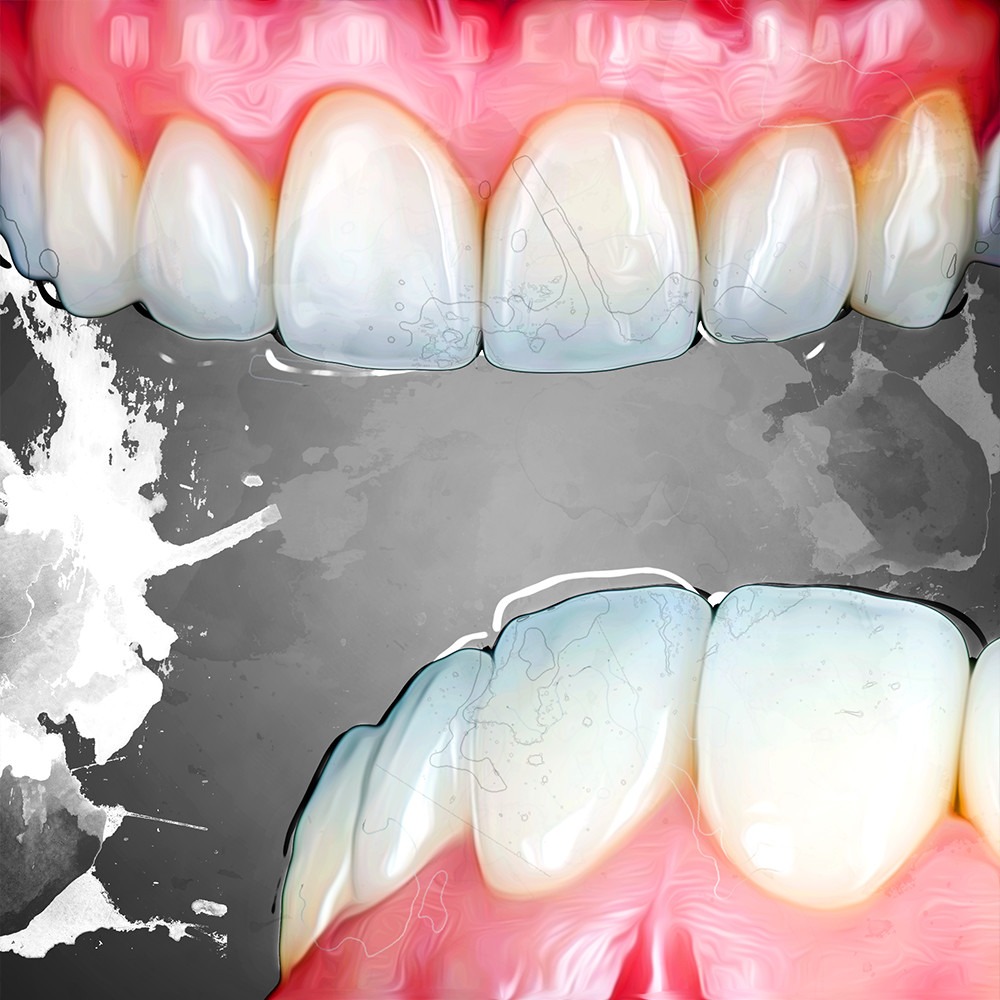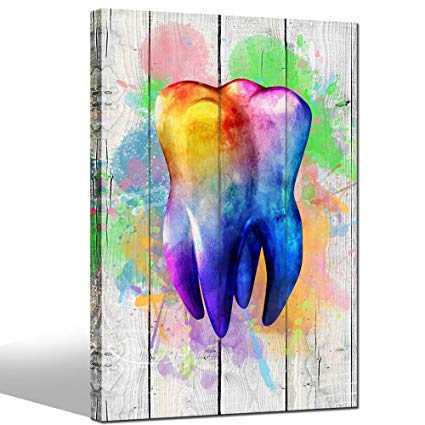Tooth Wear

In contrast to tooth decay and gum disease, an increasingly common problem is teeth which simply wear down or dissolve away to varying extents as time passes. There are 3 different forms of accelerated tooth substance loss. Each with different underlying cause and treatment.
Attrition
This is the mechanical wearing down of the chewing surfaces of teeth initiated by excessive tooth to tooth contact such as in bruxism. Attrition causes teeth to lose their form / shape and become flat and unsightly and sensitive to sweets & hot and cold drinks. Characteristic Features are usually, development of a facet (flat surface with circumscribed and well defined border). Opposing tooth facets will match perfectly in occlusion.
Treatment for Attrition
To investigate possibility of Bruxism as it can cause severe damage to teeth, fillings and any crown and bridge work. If bruxism exists, then either a soft or hard night guard should be made depending on the clinical situation. If damages to the teeth are present, to restore and repair them with non-invasive techniques and materials, which will correct the bite, prevent tooth sensitivity and improve the function as well as the aesthetics of the teeth.
Early signs of acid erosion include;
- Sensitivity
- Discolouration
- Rounded Teeth
The later stages of acid erosion can include;
- Front teeth may appear slightly transparent near their biting edges
- Advanced Discolouration
- Severe Sensitivity
- Small dents may appear on the chewing surface of the teeth
Erosion
This is loss of tooth structure (enamel and dentine) dissolved through acid erosion caused by acidic foods and drinks in our diets, or in patients with conditions like bulimia or acid-reflux.
When tooth enamel is exposed to acids, it softens and loses some of its mineral content. Saliva will help neutralise acidity, restore the mouth’s natural balance and slowly harden the tooth enamel. Nevertheless, since the tooth’s recovery process is slow, if the acid attack happens frequently, the tooth will not have a chance to repair itself. Over time, this acidic softening – especially if combined with abrasion (a general wearing of the surface by constant rubbing), for example, from toothpaste during tooth brushing – can cause significant wear, resulting in reduced thickness of enamel which can lead to a change in the texture, shape and appearance of teeth, which may also mean they become sensitive.
Treatment of Erosion
The most important rules in the management and treatment of erosion are:
- To initially treat the pain
- Treat the cause of this condition ( dietary Advice, Diet Control)
- Preventative strategies to prevent the worsening of erosion lesions
- Monitor the progression of tooth wear with study casts and photographs
- To Provide provisional or temporary treatment until the erosion is controlled and stabilized
- To utilize non-invasive restorative treatments , such as dental bonding

Treatment

Abrasion
Abrasion is the wearing down of tooth surface by incorrect brushing technique and perhaps through the use of a hard brush. This kind of tooth wear causes the gums to recede and exposes the dentine on the root surfaces of teeth which is unsightly as its yellow in colour and can make the teeth more sensitive to air.
Treatment of Abrasion
Change of oral hygiene habit (such as avoiding overzealous brushing, use of soft bristle toothbrush) is important to prevent further progression. Existing abrasion cavities can be restored by dental fillings, composite and glass ionomer are both commonly used materials for such cavities.
For severe abrasion which involves pulp of the tooth, root canal treatment and crowns may be needed.
With tooth wear, it’s very important that the cause of the tooth wear is correctly identified. For example, if the patient suffers from gastric induced Erosion but this is incorrectly identified as Attrition, then the use of night guard treatment can cause more damage to the teeth by holding gastric acids on the tooth surface for a longer time.
Also some patients suffer from more than one type of tooth wear. Their tooth wear may be caused by a combination of factors. Simply treating one type of wear and ignoring the other types at work, will not stop the damage to the patient’s teeth.
Why is Treatment So Important?
If tooth wear and erosion are left unchecked, the impact can be severe, with several problems arising. Firstly, there are the aesthetic and functional effects of the teeth wearing down and becoming shorter. Not only will this affect the appearance of your smile, but it will also affect your bite.
Secondly, if the wear and erosion move through the enamel and into the dentine, it can progress rapidly into the pulp chamber of the tooth and create pain, sensitivity, abscesses and even facial swelling.
The change in bite caused by the shortening of teeth can also create problems with the jaw joint, and in severe cases, this could require full mouth reconstruction to alleviate problems.
How to Make a Treatment Successful
Simply fixing veneers and crowns to teeth is not enough to address the problem of tooth wear and erosion. The problem with wear and erosion is that it affects a number of teeth, which complicates the treatment process.
To create a treatment plan that will be effective and long-lasting, a lot of study and functional analysis is required. The study will consist of a series of impressions and bite registration which is then set up into a mechanical jaw (also known as an articulator). To study the bite mechanics in detail, photos will also have to be taken to get an idea of the current cosmetic state of the teeth and bite.
The veneers and crowns will also have to be engineered in accordance with the pre-existing conditions of the patient. For example, if the patient grinds their teeth, the treatment will have to be designed to withstand extreme force
Preventing Teeth Erosion
Dental erosion is when the surface of your teeth, including the enamel, are eroded away exposing the underlying dentine. There are several different reasons on why you may be experiencing the discomfort of dental erosion, some causes could be due to the acids that you drink or eat, acids coming up from your stomach or by tooth grinding.
Dental erosion, if left untreated, can lead to the progressive loss of the surface of the tooth. You can help prevent tooth erosion by limiting the acidic food and drinks you consume, and by following these handy tips:
- Ensure that you have well balanced healthy diet.
- Try to reduce your intake of acidic food and drinks.
- Try to always use a straw when you are drinking an acidic drink.
- Eat fruit rather than drink fruit juice.
- Always chew a sugar-free gum after eating to help promote saliva.
- Try to rinse your mouth with water after exposure to acidic food or drinks.
- Always use a soft bristled toothbrush with fluoridated toothpaste, not an abrasive toothpaste such as some whitening products.
- Make sure if grinding your teeth is an issue that you wear a custom made splint at night to protect your teeth!
What are the risks?
Your teeth may still feel sensitive after tooth erosion treatment. This should go away over time, but in the meantime you should avoid overly hot or cold food and drink and avoid biting down on hard or crunchy foods. Your rebuilt teeth should be as strong as natural tooth enamel, but they can still stain or damage just as easily.
The cost of this treatment varies depending on how severely your teeth are worn and how many teeth need to be treated. We can give you a quote after we examine your teeth and discuss insurance and payment options at your consultation.
What does tooth erosion treatment involve?
consultation
During your consultation with our dentists, we’ll ask you questions to help us understand what the cause of your tooth wear might be and what your goals are. We’ll then carry our a thorough examination of your teeth, which may involve x-rays, and develop your personal treatment plan.
Trial smile
We’ll then take impressions (moulds) of your teeth which we’ll use to create a trial version of your new smile, which you can inspect and try out to see how it feels. You’re welcome to give us any feedback that we’ll take on board when designing your finished smile.
Restore teeth enamel
When you’re happy with your trial smile, we’ll restore your teeth enamel using a composite resin that’s been customised to match to your natural tooth shade or a different shade of your choice. We’ll then fit a protective splint to help preserve your new smile.
Follow-up
We’ll arrange a follow-up appointment after 6 months to check that you’re happy with the appearance and feel of your new smile. We can also clean and polish your restored teeth to help them look as good as possible, and discuss any other treatments you may be considering, such as veneers.
Clinic
407 Blackpool road , Preston , Lancashire PR2 2DU
Contact Us
- (01772) 726932
